Supply Chain Management of Marks and Spencer
VerifiedAdded on 2022/12/15
|12
|3330
|244
AI Summary
This report provides an overview of the supply chain management of Marks and Spencer, including its relationship with suppliers, technological service providers, legislative authorities, and industry voices. It also discusses the company's use of information systems and outsourcing in its supply chain. Additionally, the report explores the sustainability initiatives and risk reduction strategies implemented by Marks and Spencer.
Contribute Materials
Your contribution can guide someone’s learning journey. Share your
documents today.
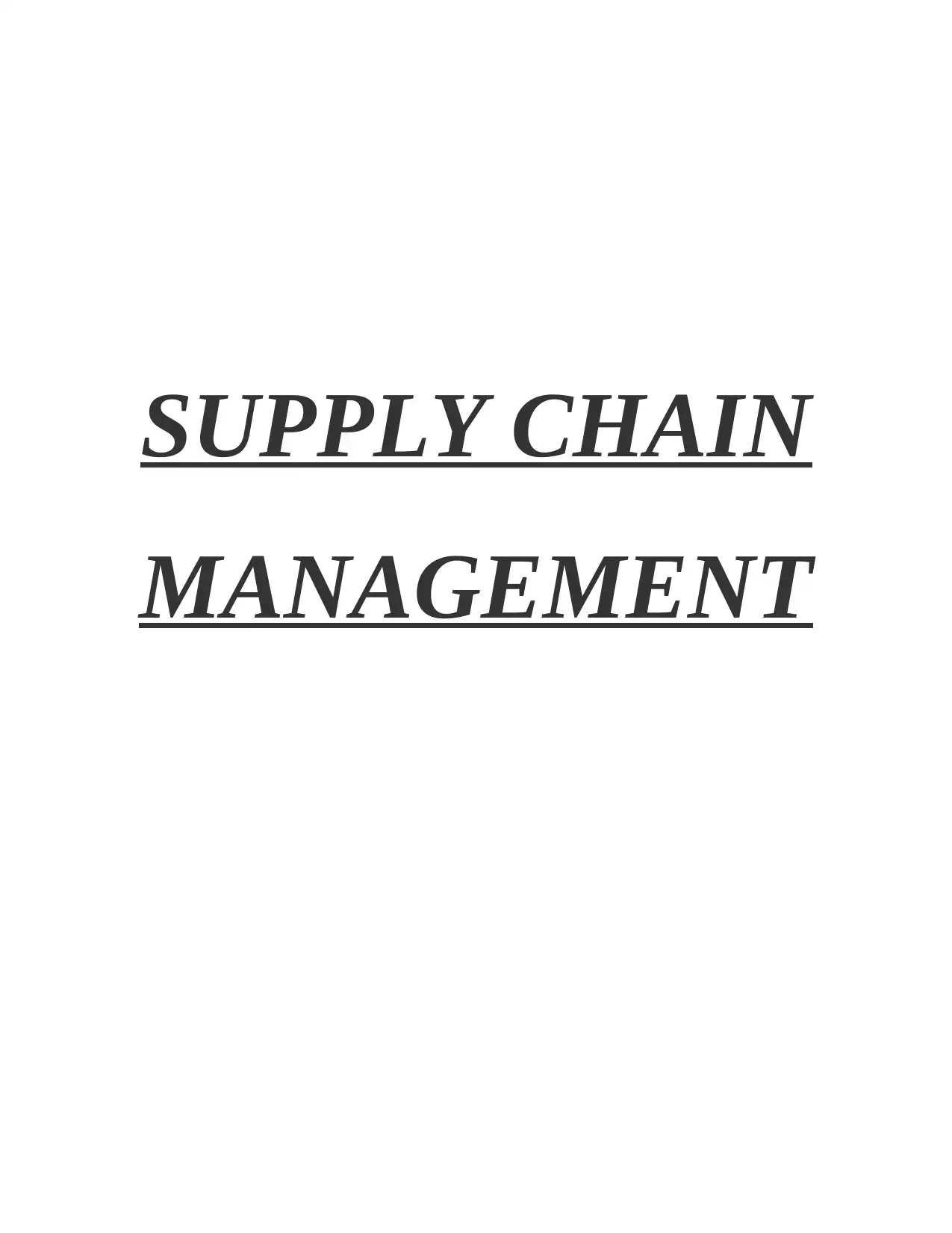
SUPPLY CHAIN
MANAGEMENT
MANAGEMENT
Secure Best Marks with AI Grader
Need help grading? Try our AI Grader for instant feedback on your assignments.
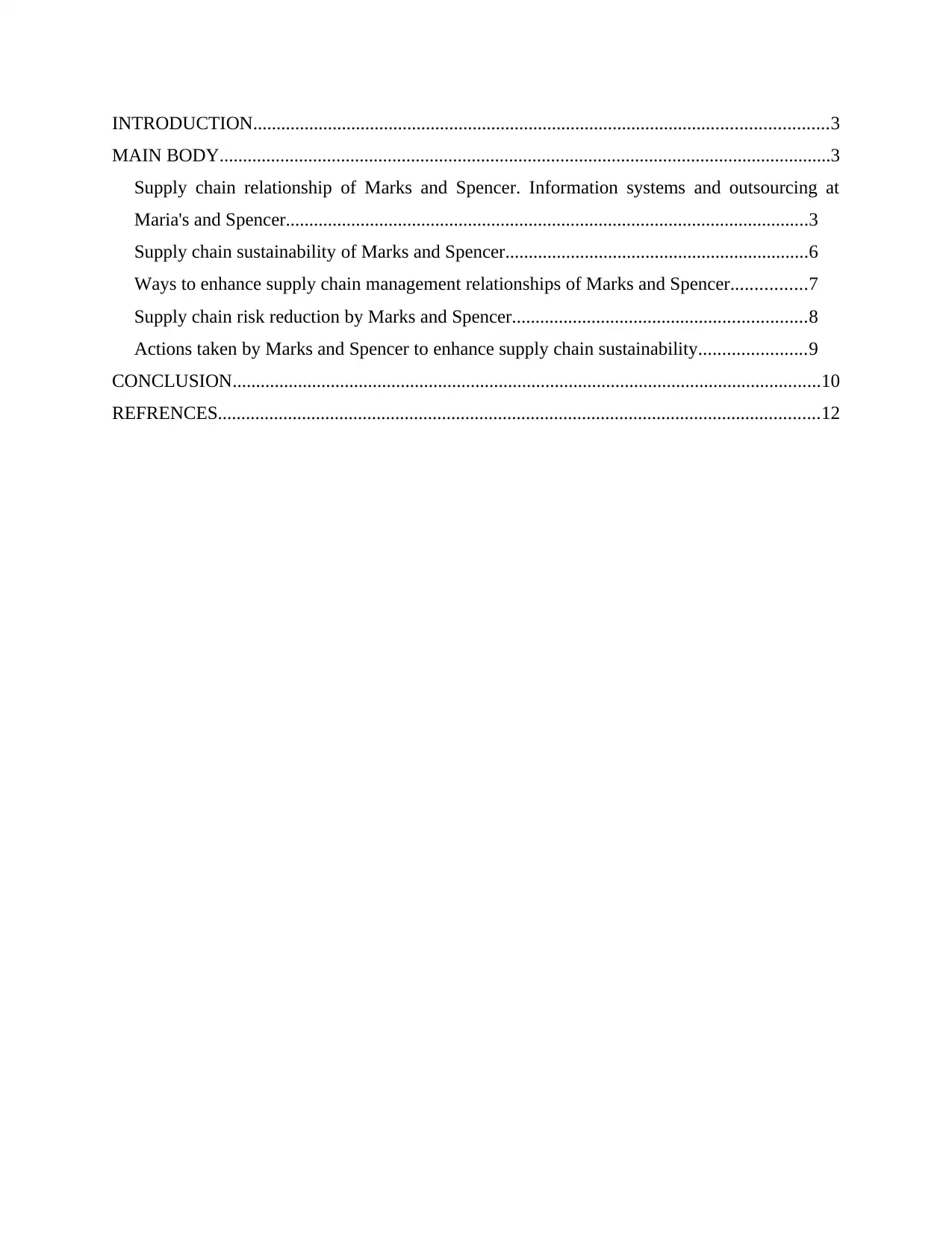
INTRODUCTION...........................................................................................................................3
MAIN BODY...................................................................................................................................3
Supply chain relationship of Marks and Spencer. Information systems and outsourcing at
Maria's and Spencer................................................................................................................3
Supply chain sustainability of Marks and Spencer.................................................................6
Ways to enhance supply chain management relationships of Marks and Spencer................7
Supply chain risk reduction by Marks and Spencer...............................................................8
Actions taken by Marks and Spencer to enhance supply chain sustainability.......................9
CONCLUSION..............................................................................................................................10
REFRENCES.................................................................................................................................12
MAIN BODY...................................................................................................................................3
Supply chain relationship of Marks and Spencer. Information systems and outsourcing at
Maria's and Spencer................................................................................................................3
Supply chain sustainability of Marks and Spencer.................................................................6
Ways to enhance supply chain management relationships of Marks and Spencer................7
Supply chain risk reduction by Marks and Spencer...............................................................8
Actions taken by Marks and Spencer to enhance supply chain sustainability.......................9
CONCLUSION..............................................................................................................................10
REFRENCES.................................................................................................................................12
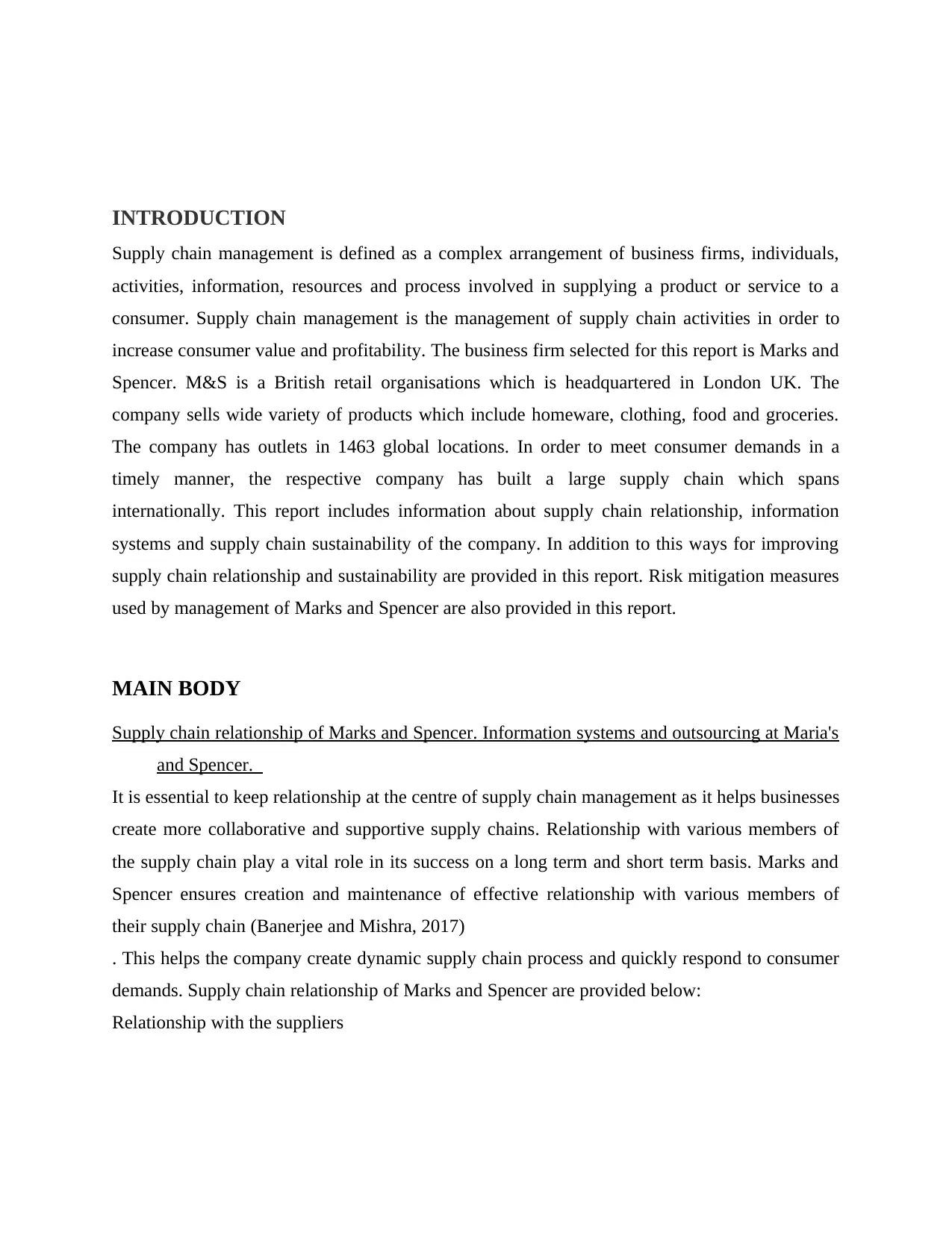
INTRODUCTION
Supply chain management is defined as a complex arrangement of business firms, individuals,
activities, information, resources and process involved in supplying a product or service to a
consumer. Supply chain management is the management of supply chain activities in order to
increase consumer value and profitability. The business firm selected for this report is Marks and
Spencer. M&S is a British retail organisations which is headquartered in London UK. The
company sells wide variety of products which include homeware, clothing, food and groceries.
The company has outlets in 1463 global locations. In order to meet consumer demands in a
timely manner, the respective company has built a large supply chain which spans
internationally. This report includes information about supply chain relationship, information
systems and supply chain sustainability of the company. In addition to this ways for improving
supply chain relationship and sustainability are provided in this report. Risk mitigation measures
used by management of Marks and Spencer are also provided in this report.
MAIN BODY
Supply chain relationship of Marks and Spencer. Information systems and outsourcing at Maria's
and Spencer.
It is essential to keep relationship at the centre of supply chain management as it helps businesses
create more collaborative and supportive supply chains. Relationship with various members of
the supply chain play a vital role in its success on a long term and short term basis. Marks and
Spencer ensures creation and maintenance of effective relationship with various members of
their supply chain (Banerjee and Mishra, 2017)
. This helps the company create dynamic supply chain process and quickly respond to consumer
demands. Supply chain relationship of Marks and Spencer are provided below:
Relationship with the suppliers
Supply chain management is defined as a complex arrangement of business firms, individuals,
activities, information, resources and process involved in supplying a product or service to a
consumer. Supply chain management is the management of supply chain activities in order to
increase consumer value and profitability. The business firm selected for this report is Marks and
Spencer. M&S is a British retail organisations which is headquartered in London UK. The
company sells wide variety of products which include homeware, clothing, food and groceries.
The company has outlets in 1463 global locations. In order to meet consumer demands in a
timely manner, the respective company has built a large supply chain which spans
internationally. This report includes information about supply chain relationship, information
systems and supply chain sustainability of the company. In addition to this ways for improving
supply chain relationship and sustainability are provided in this report. Risk mitigation measures
used by management of Marks and Spencer are also provided in this report.
MAIN BODY
Supply chain relationship of Marks and Spencer. Information systems and outsourcing at Maria's
and Spencer.
It is essential to keep relationship at the centre of supply chain management as it helps businesses
create more collaborative and supportive supply chains. Relationship with various members of
the supply chain play a vital role in its success on a long term and short term basis. Marks and
Spencer ensures creation and maintenance of effective relationship with various members of
their supply chain (Banerjee and Mishra, 2017)
. This helps the company create dynamic supply chain process and quickly respond to consumer
demands. Supply chain relationship of Marks and Spencer are provided below:
Relationship with the suppliers
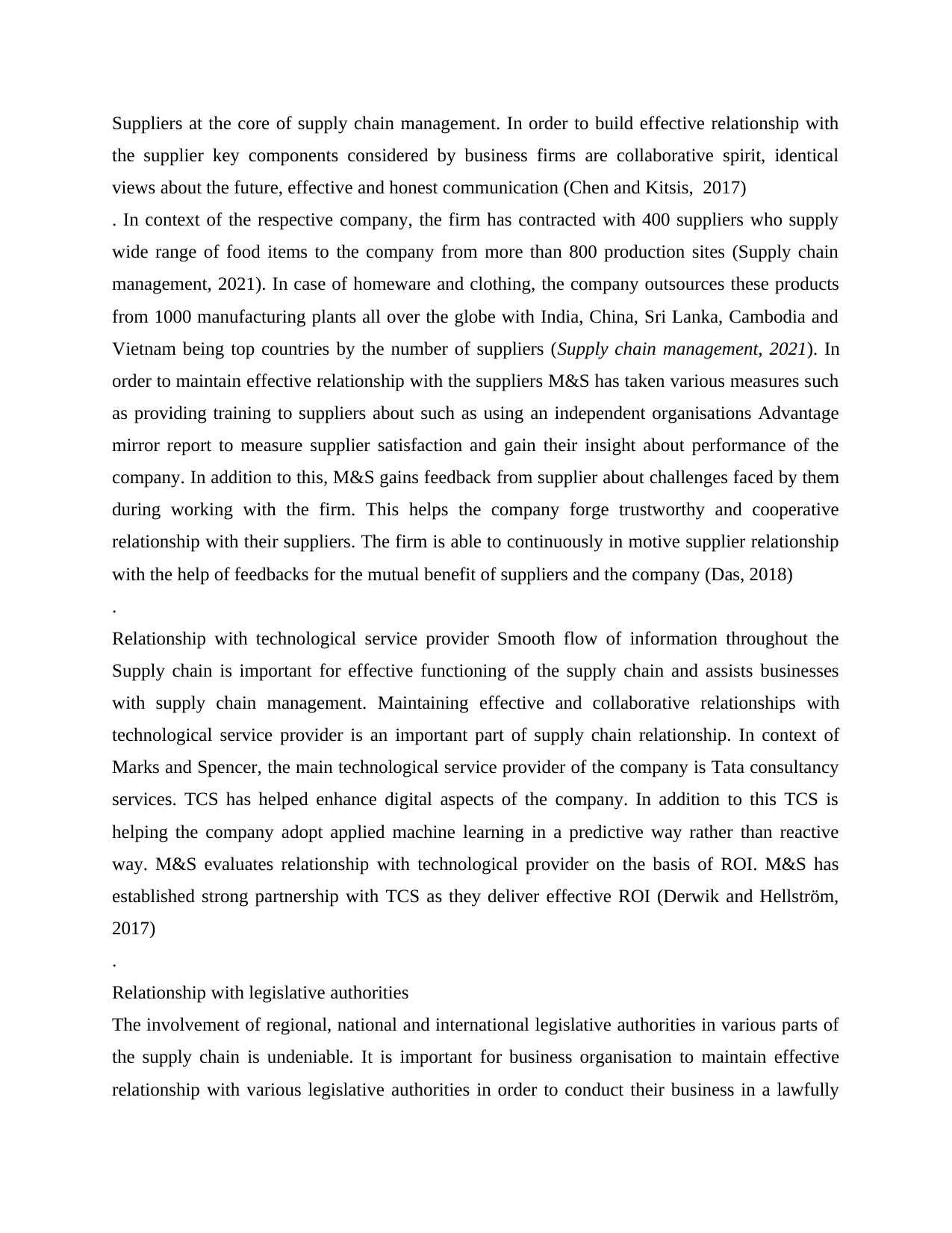
Suppliers at the core of supply chain management. In order to build effective relationship with
the supplier key components considered by business firms are collaborative spirit, identical
views about the future, effective and honest communication (Chen and Kitsis, 2017)
. In context of the respective company, the firm has contracted with 400 suppliers who supply
wide range of food items to the company from more than 800 production sites (Supply chain
management, 2021). In case of homeware and clothing, the company outsources these products
from 1000 manufacturing plants all over the globe with India, China, Sri Lanka, Cambodia and
Vietnam being top countries by the number of suppliers (Supply chain management, 2021). In
order to maintain effective relationship with the suppliers M&S has taken various measures such
as providing training to suppliers about such as using an independent organisations Advantage
mirror report to measure supplier satisfaction and gain their insight about performance of the
company. In addition to this, M&S gains feedback from supplier about challenges faced by them
during working with the firm. This helps the company forge trustworthy and cooperative
relationship with their suppliers. The firm is able to continuously in motive supplier relationship
with the help of feedbacks for the mutual benefit of suppliers and the company (Das, 2018)
.
Relationship with technological service provider Smooth flow of information throughout the
Supply chain is important for effective functioning of the supply chain and assists businesses
with supply chain management. Maintaining effective and collaborative relationships with
technological service provider is an important part of supply chain relationship. In context of
Marks and Spencer, the main technological service provider of the company is Tata consultancy
services. TCS has helped enhance digital aspects of the company. In addition to this TCS is
helping the company adopt applied machine learning in a predictive way rather than reactive
way. M&S evaluates relationship with technological provider on the basis of ROI. M&S has
established strong partnership with TCS as they deliver effective ROI (Derwik and Hellström,
2017)
.
Relationship with legislative authorities
The involvement of regional, national and international legislative authorities in various parts of
the supply chain is undeniable. It is important for business organisation to maintain effective
relationship with various legislative authorities in order to conduct their business in a lawfully
the supplier key components considered by business firms are collaborative spirit, identical
views about the future, effective and honest communication (Chen and Kitsis, 2017)
. In context of the respective company, the firm has contracted with 400 suppliers who supply
wide range of food items to the company from more than 800 production sites (Supply chain
management, 2021). In case of homeware and clothing, the company outsources these products
from 1000 manufacturing plants all over the globe with India, China, Sri Lanka, Cambodia and
Vietnam being top countries by the number of suppliers (Supply chain management, 2021). In
order to maintain effective relationship with the suppliers M&S has taken various measures such
as providing training to suppliers about such as using an independent organisations Advantage
mirror report to measure supplier satisfaction and gain their insight about performance of the
company. In addition to this, M&S gains feedback from supplier about challenges faced by them
during working with the firm. This helps the company forge trustworthy and cooperative
relationship with their suppliers. The firm is able to continuously in motive supplier relationship
with the help of feedbacks for the mutual benefit of suppliers and the company (Das, 2018)
.
Relationship with technological service provider Smooth flow of information throughout the
Supply chain is important for effective functioning of the supply chain and assists businesses
with supply chain management. Maintaining effective and collaborative relationships with
technological service provider is an important part of supply chain relationship. In context of
Marks and Spencer, the main technological service provider of the company is Tata consultancy
services. TCS has helped enhance digital aspects of the company. In addition to this TCS is
helping the company adopt applied machine learning in a predictive way rather than reactive
way. M&S evaluates relationship with technological provider on the basis of ROI. M&S has
established strong partnership with TCS as they deliver effective ROI (Derwik and Hellström,
2017)
.
Relationship with legislative authorities
The involvement of regional, national and international legislative authorities in various parts of
the supply chain is undeniable. It is important for business organisation to maintain effective
relationship with various legislative authorities in order to conduct their business in a lawfully
Secure Best Marks with AI Grader
Need help grading? Try our AI Grader for instant feedback on your assignments.
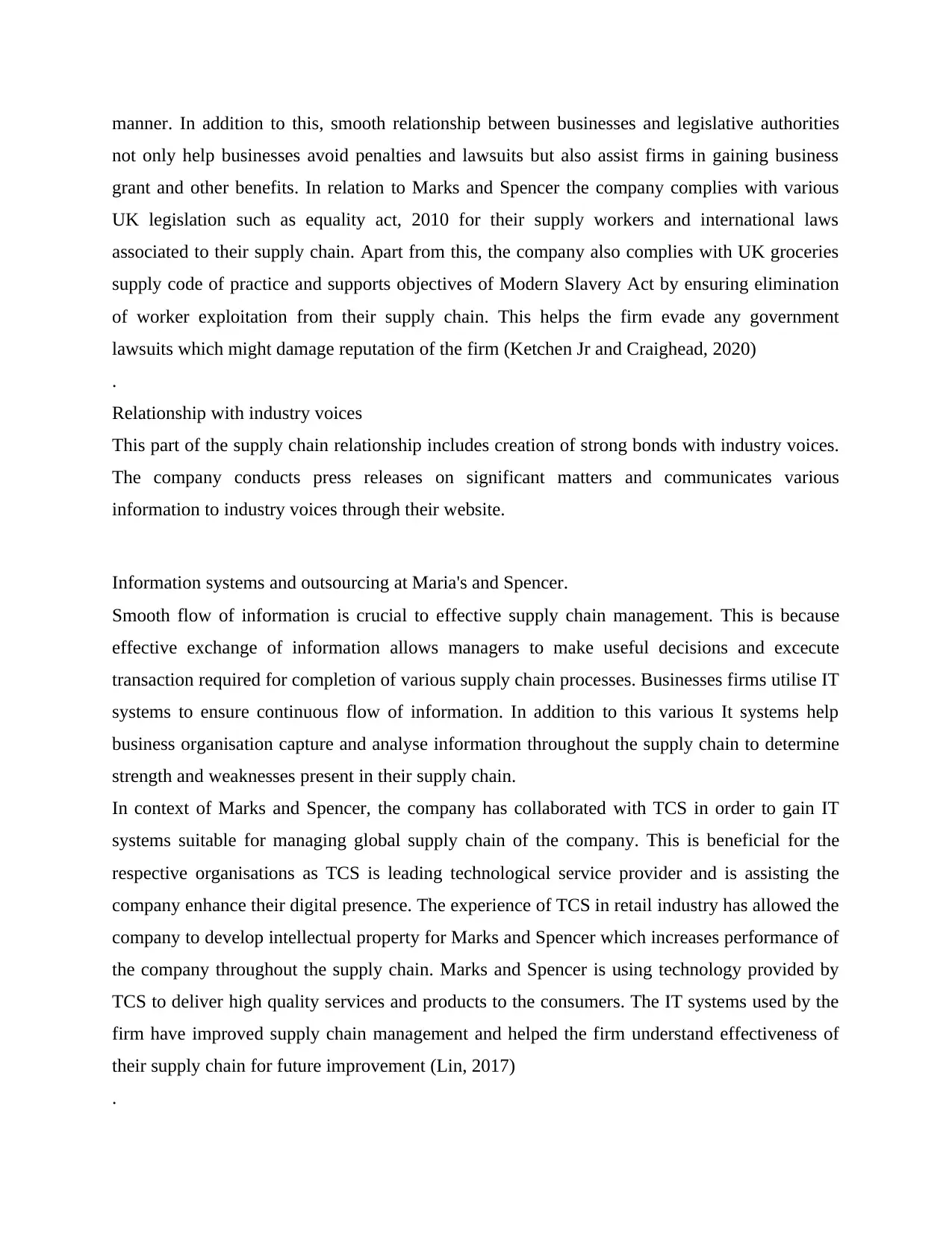
manner. In addition to this, smooth relationship between businesses and legislative authorities
not only help businesses avoid penalties and lawsuits but also assist firms in gaining business
grant and other benefits. In relation to Marks and Spencer the company complies with various
UK legislation such as equality act, 2010 for their supply workers and international laws
associated to their supply chain. Apart from this, the company also complies with UK groceries
supply code of practice and supports objectives of Modern Slavery Act by ensuring elimination
of worker exploitation from their supply chain. This helps the firm evade any government
lawsuits which might damage reputation of the firm (Ketchen Jr and Craighead, 2020)
.
Relationship with industry voices
This part of the supply chain relationship includes creation of strong bonds with industry voices.
The company conducts press releases on significant matters and communicates various
information to industry voices through their website.
Information systems and outsourcing at Maria's and Spencer.
Smooth flow of information is crucial to effective supply chain management. This is because
effective exchange of information allows managers to make useful decisions and excecute
transaction required for completion of various supply chain processes. Businesses firms utilise IT
systems to ensure continuous flow of information. In addition to this various It systems help
business organisation capture and analyse information throughout the supply chain to determine
strength and weaknesses present in their supply chain.
In context of Marks and Spencer, the company has collaborated with TCS in order to gain IT
systems suitable for managing global supply chain of the company. This is beneficial for the
respective organisations as TCS is leading technological service provider and is assisting the
company enhance their digital presence. The experience of TCS in retail industry has allowed the
company to develop intellectual property for Marks and Spencer which increases performance of
the company throughout the supply chain. Marks and Spencer is using technology provided by
TCS to deliver high quality services and products to the consumers. The IT systems used by the
firm have improved supply chain management and helped the firm understand effectiveness of
their supply chain for future improvement (Lin, 2017)
.
not only help businesses avoid penalties and lawsuits but also assist firms in gaining business
grant and other benefits. In relation to Marks and Spencer the company complies with various
UK legislation such as equality act, 2010 for their supply workers and international laws
associated to their supply chain. Apart from this, the company also complies with UK groceries
supply code of practice and supports objectives of Modern Slavery Act by ensuring elimination
of worker exploitation from their supply chain. This helps the firm evade any government
lawsuits which might damage reputation of the firm (Ketchen Jr and Craighead, 2020)
.
Relationship with industry voices
This part of the supply chain relationship includes creation of strong bonds with industry voices.
The company conducts press releases on significant matters and communicates various
information to industry voices through their website.
Information systems and outsourcing at Maria's and Spencer.
Smooth flow of information is crucial to effective supply chain management. This is because
effective exchange of information allows managers to make useful decisions and excecute
transaction required for completion of various supply chain processes. Businesses firms utilise IT
systems to ensure continuous flow of information. In addition to this various It systems help
business organisation capture and analyse information throughout the supply chain to determine
strength and weaknesses present in their supply chain.
In context of Marks and Spencer, the company has collaborated with TCS in order to gain IT
systems suitable for managing global supply chain of the company. This is beneficial for the
respective organisations as TCS is leading technological service provider and is assisting the
company enhance their digital presence. The experience of TCS in retail industry has allowed the
company to develop intellectual property for Marks and Spencer which increases performance of
the company throughout the supply chain. Marks and Spencer is using technology provided by
TCS to deliver high quality services and products to the consumers. The IT systems used by the
firm have improved supply chain management and helped the firm understand effectiveness of
their supply chain for future improvement (Lin, 2017)
.
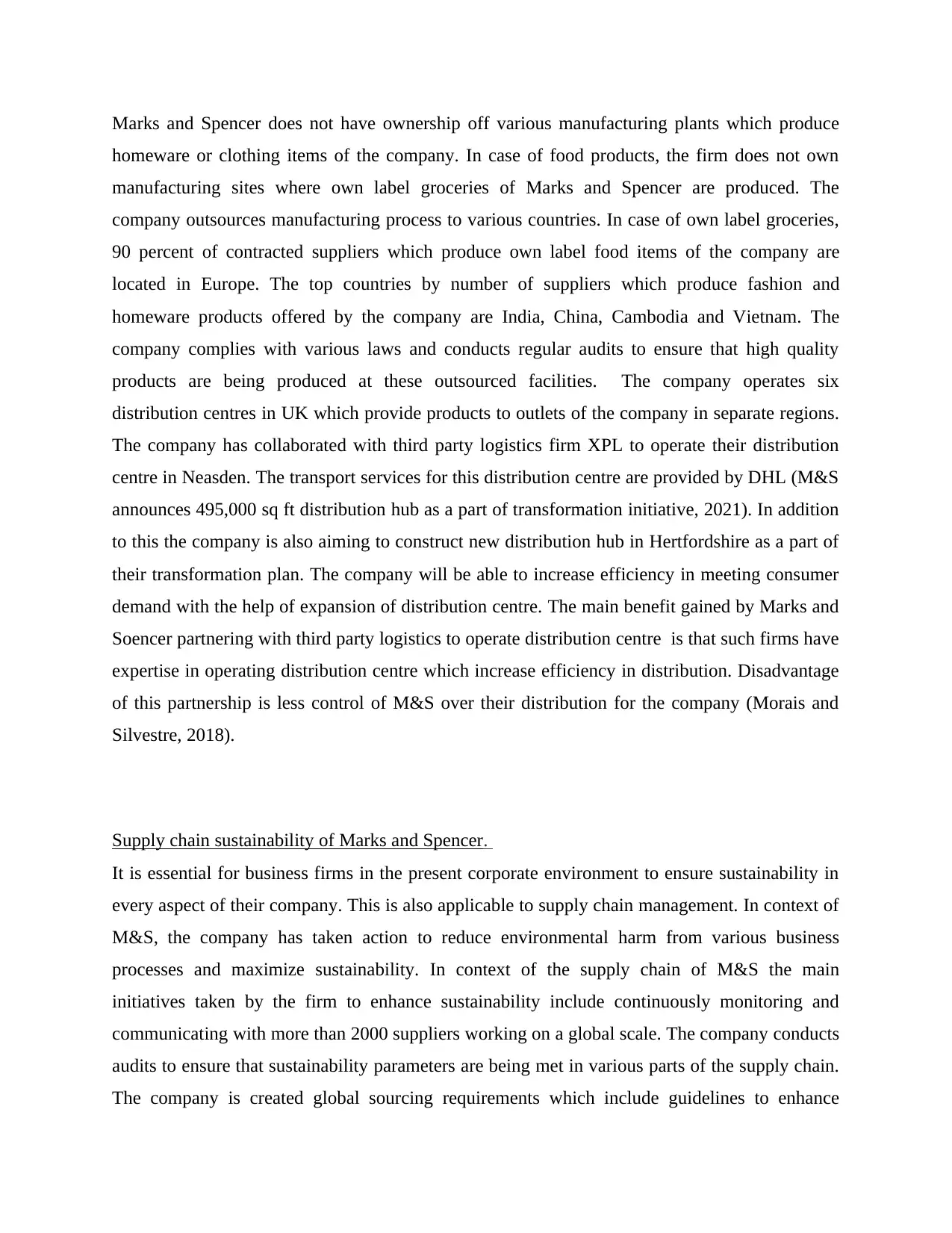
Marks and Spencer does not have ownership off various manufacturing plants which produce
homeware or clothing items of the company. In case of food products, the firm does not own
manufacturing sites where own label groceries of Marks and Spencer are produced. The
company outsources manufacturing process to various countries. In case of own label groceries,
90 percent of contracted suppliers which produce own label food items of the company are
located in Europe. The top countries by number of suppliers which produce fashion and
homeware products offered by the company are India, China, Cambodia and Vietnam. The
company complies with various laws and conducts regular audits to ensure that high quality
products are being produced at these outsourced facilities. The company operates six
distribution centres in UK which provide products to outlets of the company in separate regions.
The company has collaborated with third party logistics firm XPL to operate their distribution
centre in Neasden. The transport services for this distribution centre are provided by DHL (M&S
announces 495,000 sq ft distribution hub as a part of transformation initiative, 2021). In addition
to this the company is also aiming to construct new distribution hub in Hertfordshire as a part of
their transformation plan. The company will be able to increase efficiency in meeting consumer
demand with the help of expansion of distribution centre. The main benefit gained by Marks and
Soencer partnering with third party logistics to operate distribution centre is that such firms have
expertise in operating distribution centre which increase efficiency in distribution. Disadvantage
of this partnership is less control of M&S over their distribution for the company (Morais and
Silvestre, 2018).
Supply chain sustainability of Marks and Spencer.
It is essential for business firms in the present corporate environment to ensure sustainability in
every aspect of their company. This is also applicable to supply chain management. In context of
M&S, the company has taken action to reduce environmental harm from various business
processes and maximize sustainability. In context of the supply chain of M&S the main
initiatives taken by the firm to enhance sustainability include continuously monitoring and
communicating with more than 2000 suppliers working on a global scale. The company conducts
audits to ensure that sustainability parameters are being met in various parts of the supply chain.
The company is created global sourcing requirements which include guidelines to enhance
homeware or clothing items of the company. In case of food products, the firm does not own
manufacturing sites where own label groceries of Marks and Spencer are produced. The
company outsources manufacturing process to various countries. In case of own label groceries,
90 percent of contracted suppliers which produce own label food items of the company are
located in Europe. The top countries by number of suppliers which produce fashion and
homeware products offered by the company are India, China, Cambodia and Vietnam. The
company complies with various laws and conducts regular audits to ensure that high quality
products are being produced at these outsourced facilities. The company operates six
distribution centres in UK which provide products to outlets of the company in separate regions.
The company has collaborated with third party logistics firm XPL to operate their distribution
centre in Neasden. The transport services for this distribution centre are provided by DHL (M&S
announces 495,000 sq ft distribution hub as a part of transformation initiative, 2021). In addition
to this the company is also aiming to construct new distribution hub in Hertfordshire as a part of
their transformation plan. The company will be able to increase efficiency in meeting consumer
demand with the help of expansion of distribution centre. The main benefit gained by Marks and
Soencer partnering with third party logistics to operate distribution centre is that such firms have
expertise in operating distribution centre which increase efficiency in distribution. Disadvantage
of this partnership is less control of M&S over their distribution for the company (Morais and
Silvestre, 2018).
Supply chain sustainability of Marks and Spencer.
It is essential for business firms in the present corporate environment to ensure sustainability in
every aspect of their company. This is also applicable to supply chain management. In context of
M&S, the company has taken action to reduce environmental harm from various business
processes and maximize sustainability. In context of the supply chain of M&S the main
initiatives taken by the firm to enhance sustainability include continuously monitoring and
communicating with more than 2000 suppliers working on a global scale. The company conducts
audits to ensure that sustainability parameters are being met in various parts of the supply chain.
The company is created global sourcing requirements which include guidelines to enhance
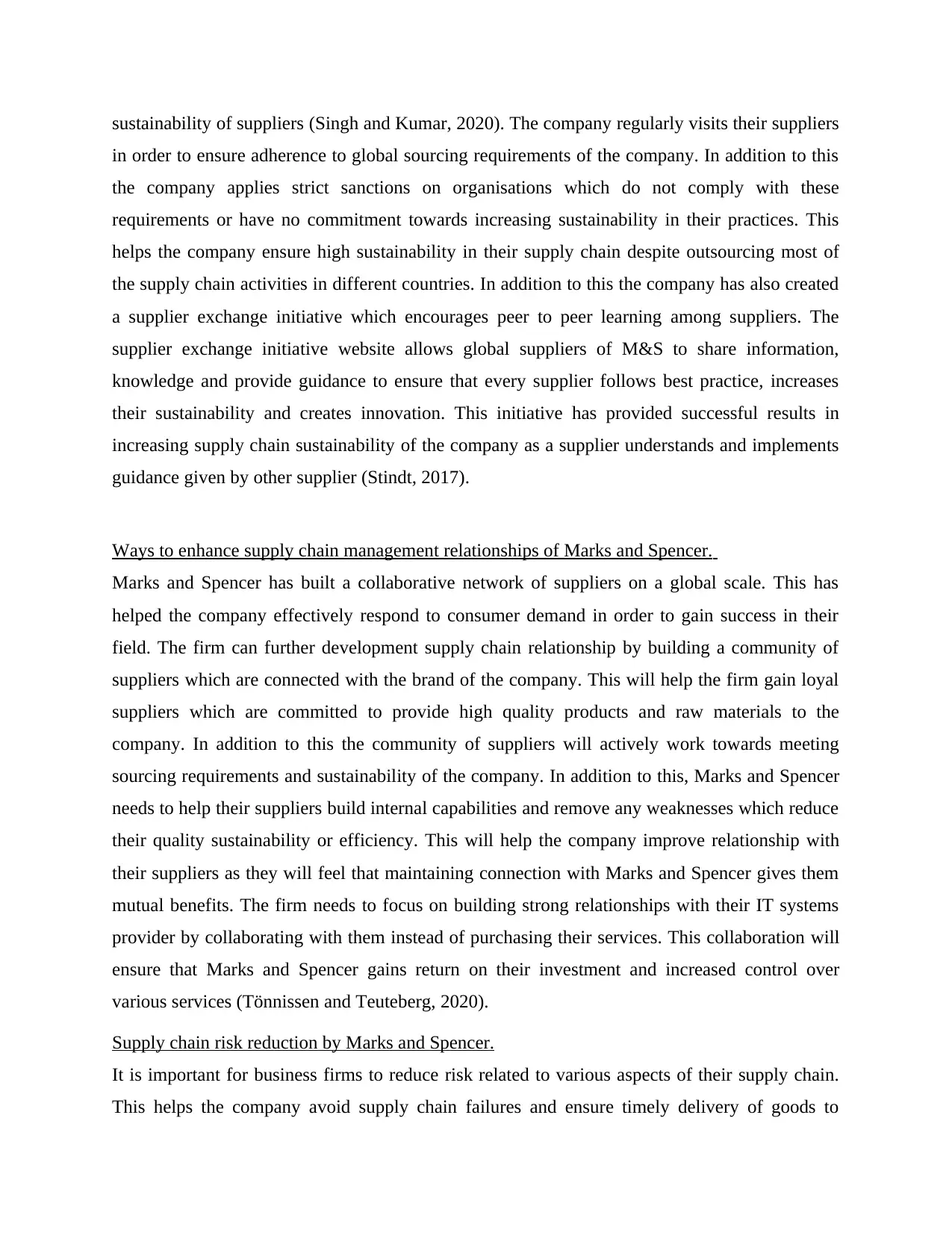
sustainability of suppliers (Singh and Kumar, 2020). The company regularly visits their suppliers
in order to ensure adherence to global sourcing requirements of the company. In addition to this
the company applies strict sanctions on organisations which do not comply with these
requirements or have no commitment towards increasing sustainability in their practices. This
helps the company ensure high sustainability in their supply chain despite outsourcing most of
the supply chain activities in different countries. In addition to this the company has also created
a supplier exchange initiative which encourages peer to peer learning among suppliers. The
supplier exchange initiative website allows global suppliers of M&S to share information,
knowledge and provide guidance to ensure that every supplier follows best practice, increases
their sustainability and creates innovation. This initiative has provided successful results in
increasing supply chain sustainability of the company as a supplier understands and implements
guidance given by other supplier (Stindt, 2017).
Ways to enhance supply chain management relationships of Marks and Spencer.
Marks and Spencer has built a collaborative network of suppliers on a global scale. This has
helped the company effectively respond to consumer demand in order to gain success in their
field. The firm can further development supply chain relationship by building a community of
suppliers which are connected with the brand of the company. This will help the firm gain loyal
suppliers which are committed to provide high quality products and raw materials to the
company. In addition to this the community of suppliers will actively work towards meeting
sourcing requirements and sustainability of the company. In addition to this, Marks and Spencer
needs to help their suppliers build internal capabilities and remove any weaknesses which reduce
their quality sustainability or efficiency. This will help the company improve relationship with
their suppliers as they will feel that maintaining connection with Marks and Spencer gives them
mutual benefits. The firm needs to focus on building strong relationships with their IT systems
provider by collaborating with them instead of purchasing their services. This collaboration will
ensure that Marks and Spencer gains return on their investment and increased control over
various services (Tönnissen and Teuteberg, 2020).
Supply chain risk reduction by Marks and Spencer.
It is important for business firms to reduce risk related to various aspects of their supply chain.
This helps the company avoid supply chain failures and ensure timely delivery of goods to
in order to ensure adherence to global sourcing requirements of the company. In addition to this
the company applies strict sanctions on organisations which do not comply with these
requirements or have no commitment towards increasing sustainability in their practices. This
helps the company ensure high sustainability in their supply chain despite outsourcing most of
the supply chain activities in different countries. In addition to this the company has also created
a supplier exchange initiative which encourages peer to peer learning among suppliers. The
supplier exchange initiative website allows global suppliers of M&S to share information,
knowledge and provide guidance to ensure that every supplier follows best practice, increases
their sustainability and creates innovation. This initiative has provided successful results in
increasing supply chain sustainability of the company as a supplier understands and implements
guidance given by other supplier (Stindt, 2017).
Ways to enhance supply chain management relationships of Marks and Spencer.
Marks and Spencer has built a collaborative network of suppliers on a global scale. This has
helped the company effectively respond to consumer demand in order to gain success in their
field. The firm can further development supply chain relationship by building a community of
suppliers which are connected with the brand of the company. This will help the firm gain loyal
suppliers which are committed to provide high quality products and raw materials to the
company. In addition to this the community of suppliers will actively work towards meeting
sourcing requirements and sustainability of the company. In addition to this, Marks and Spencer
needs to help their suppliers build internal capabilities and remove any weaknesses which reduce
their quality sustainability or efficiency. This will help the company improve relationship with
their suppliers as they will feel that maintaining connection with Marks and Spencer gives them
mutual benefits. The firm needs to focus on building strong relationships with their IT systems
provider by collaborating with them instead of purchasing their services. This collaboration will
ensure that Marks and Spencer gains return on their investment and increased control over
various services (Tönnissen and Teuteberg, 2020).
Supply chain risk reduction by Marks and Spencer.
It is important for business firms to reduce risk related to various aspects of their supply chain.
This helps the company avoid supply chain failures and ensure timely delivery of goods to
Paraphrase This Document
Need a fresh take? Get an instant paraphrase of this document with our AI Paraphraser
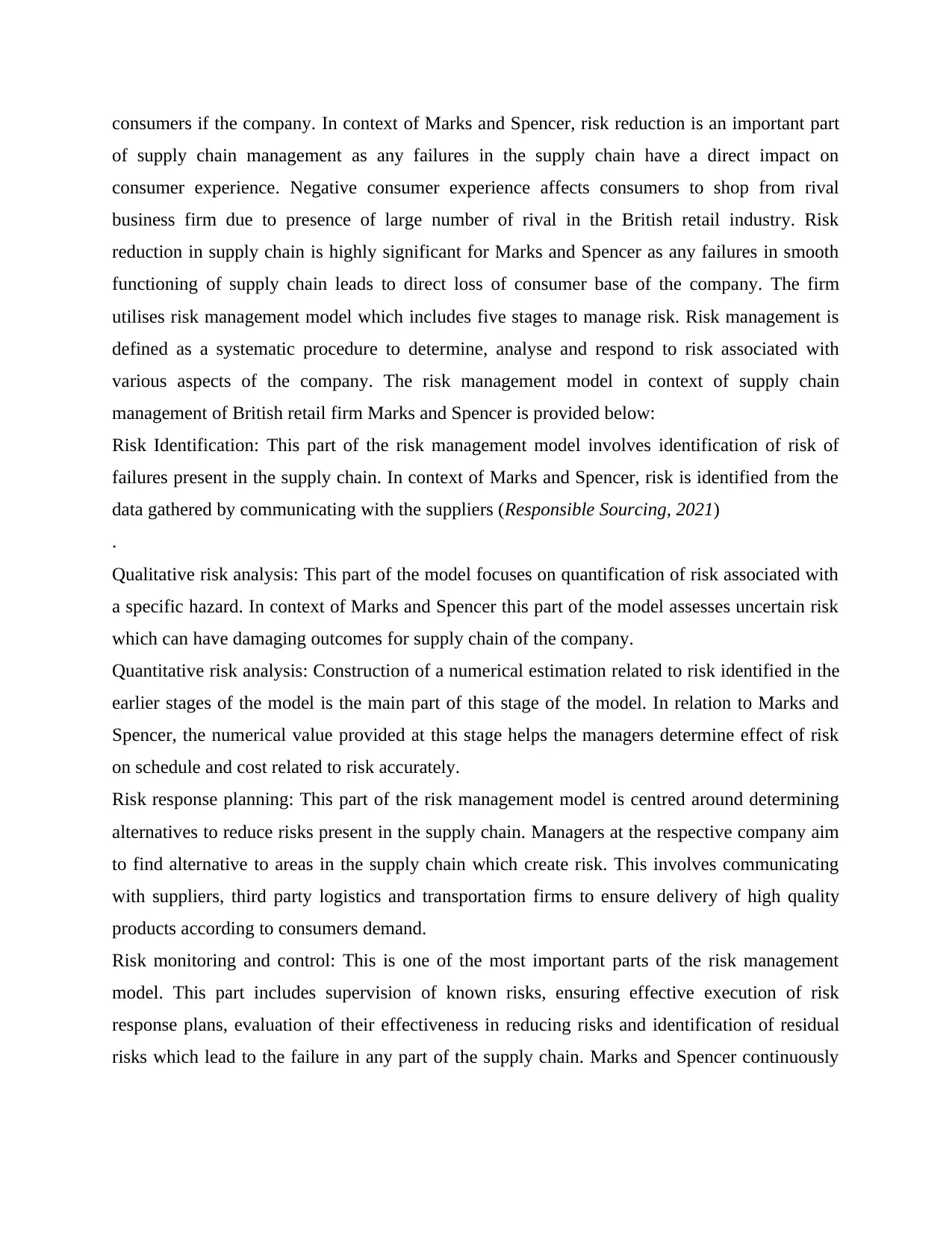
consumers if the company. In context of Marks and Spencer, risk reduction is an important part
of supply chain management as any failures in the supply chain have a direct impact on
consumer experience. Negative consumer experience affects consumers to shop from rival
business firm due to presence of large number of rival in the British retail industry. Risk
reduction in supply chain is highly significant for Marks and Spencer as any failures in smooth
functioning of supply chain leads to direct loss of consumer base of the company. The firm
utilises risk management model which includes five stages to manage risk. Risk management is
defined as a systematic procedure to determine, analyse and respond to risk associated with
various aspects of the company. The risk management model in context of supply chain
management of British retail firm Marks and Spencer is provided below:
Risk Identification: This part of the risk management model involves identification of risk of
failures present in the supply chain. In context of Marks and Spencer, risk is identified from the
data gathered by communicating with the suppliers (Responsible Sourcing, 2021)
.
Qualitative risk analysis: This part of the model focuses on quantification of risk associated with
a specific hazard. In context of Marks and Spencer this part of the model assesses uncertain risk
which can have damaging outcomes for supply chain of the company.
Quantitative risk analysis: Construction of a numerical estimation related to risk identified in the
earlier stages of the model is the main part of this stage of the model. In relation to Marks and
Spencer, the numerical value provided at this stage helps the managers determine effect of risk
on schedule and cost related to risk accurately.
Risk response planning: This part of the risk management model is centred around determining
alternatives to reduce risks present in the supply chain. Managers at the respective company aim
to find alternative to areas in the supply chain which create risk. This involves communicating
with suppliers, third party logistics and transportation firms to ensure delivery of high quality
products according to consumers demand.
Risk monitoring and control: This is one of the most important parts of the risk management
model. This part includes supervision of known risks, ensuring effective execution of risk
response plans, evaluation of their effectiveness in reducing risks and identification of residual
risks which lead to the failure in any part of the supply chain. Marks and Spencer continuously
of supply chain management as any failures in the supply chain have a direct impact on
consumer experience. Negative consumer experience affects consumers to shop from rival
business firm due to presence of large number of rival in the British retail industry. Risk
reduction in supply chain is highly significant for Marks and Spencer as any failures in smooth
functioning of supply chain leads to direct loss of consumer base of the company. The firm
utilises risk management model which includes five stages to manage risk. Risk management is
defined as a systematic procedure to determine, analyse and respond to risk associated with
various aspects of the company. The risk management model in context of supply chain
management of British retail firm Marks and Spencer is provided below:
Risk Identification: This part of the risk management model involves identification of risk of
failures present in the supply chain. In context of Marks and Spencer, risk is identified from the
data gathered by communicating with the suppliers (Responsible Sourcing, 2021)
.
Qualitative risk analysis: This part of the model focuses on quantification of risk associated with
a specific hazard. In context of Marks and Spencer this part of the model assesses uncertain risk
which can have damaging outcomes for supply chain of the company.
Quantitative risk analysis: Construction of a numerical estimation related to risk identified in the
earlier stages of the model is the main part of this stage of the model. In relation to Marks and
Spencer, the numerical value provided at this stage helps the managers determine effect of risk
on schedule and cost related to risk accurately.
Risk response planning: This part of the risk management model is centred around determining
alternatives to reduce risks present in the supply chain. Managers at the respective company aim
to find alternative to areas in the supply chain which create risk. This involves communicating
with suppliers, third party logistics and transportation firms to ensure delivery of high quality
products according to consumers demand.
Risk monitoring and control: This is one of the most important parts of the risk management
model. This part includes supervision of known risks, ensuring effective execution of risk
response plans, evaluation of their effectiveness in reducing risks and identification of residual
risks which lead to the failure in any part of the supply chain. Marks and Spencer continuously
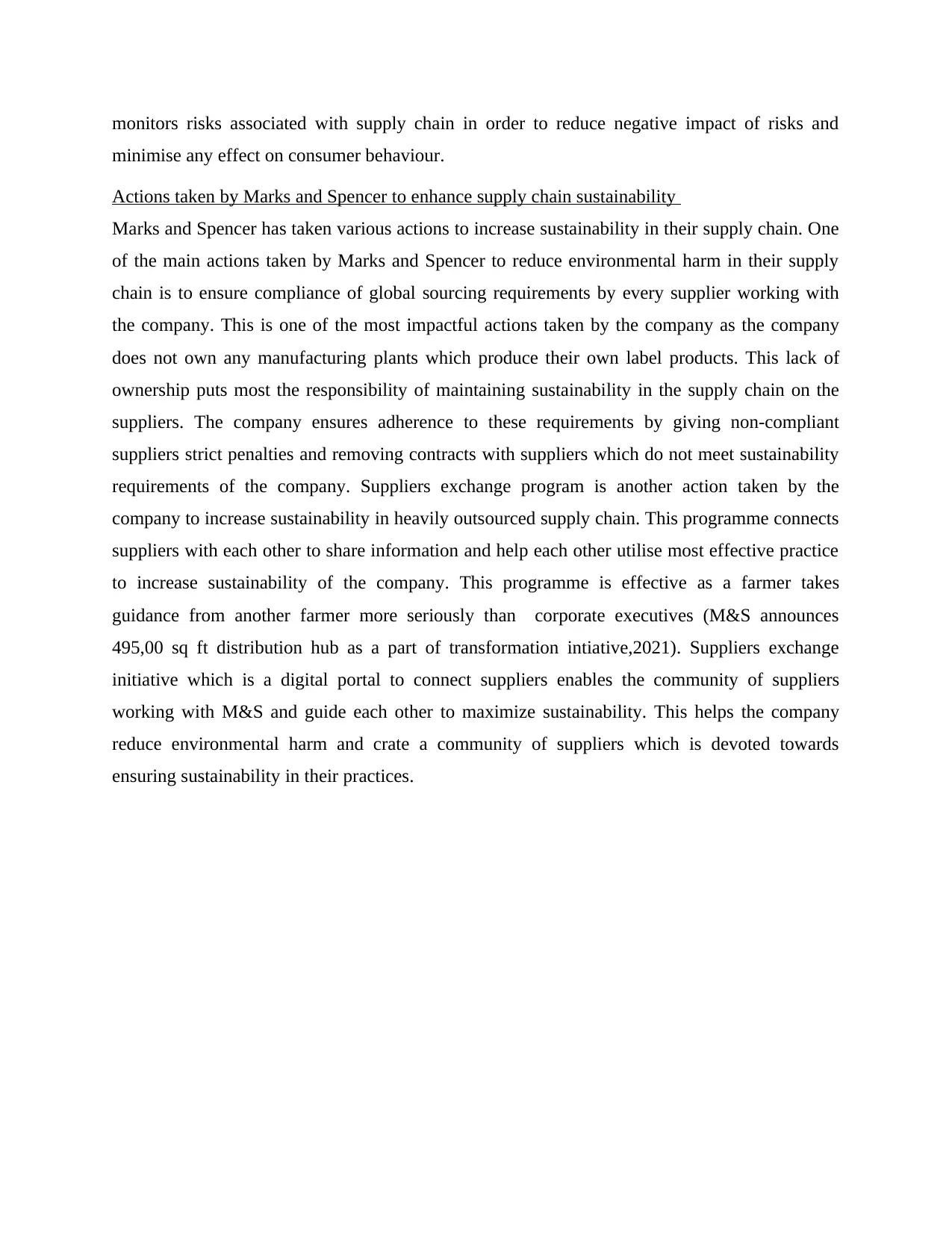
monitors risks associated with supply chain in order to reduce negative impact of risks and
minimise any effect on consumer behaviour.
Actions taken by Marks and Spencer to enhance supply chain sustainability
Marks and Spencer has taken various actions to increase sustainability in their supply chain. One
of the main actions taken by Marks and Spencer to reduce environmental harm in their supply
chain is to ensure compliance of global sourcing requirements by every supplier working with
the company. This is one of the most impactful actions taken by the company as the company
does not own any manufacturing plants which produce their own label products. This lack of
ownership puts most the responsibility of maintaining sustainability in the supply chain on the
suppliers. The company ensures adherence to these requirements by giving non-compliant
suppliers strict penalties and removing contracts with suppliers which do not meet sustainability
requirements of the company. Suppliers exchange program is another action taken by the
company to increase sustainability in heavily outsourced supply chain. This programme connects
suppliers with each other to share information and help each other utilise most effective practice
to increase sustainability of the company. This programme is effective as a farmer takes
guidance from another farmer more seriously than corporate executives (M&S announces
495,00 sq ft distribution hub as a part of transformation intiative,2021). Suppliers exchange
initiative which is a digital portal to connect suppliers enables the community of suppliers
working with M&S and guide each other to maximize sustainability. This helps the company
reduce environmental harm and crate a community of suppliers which is devoted towards
ensuring sustainability in their practices.
minimise any effect on consumer behaviour.
Actions taken by Marks and Spencer to enhance supply chain sustainability
Marks and Spencer has taken various actions to increase sustainability in their supply chain. One
of the main actions taken by Marks and Spencer to reduce environmental harm in their supply
chain is to ensure compliance of global sourcing requirements by every supplier working with
the company. This is one of the most impactful actions taken by the company as the company
does not own any manufacturing plants which produce their own label products. This lack of
ownership puts most the responsibility of maintaining sustainability in the supply chain on the
suppliers. The company ensures adherence to these requirements by giving non-compliant
suppliers strict penalties and removing contracts with suppliers which do not meet sustainability
requirements of the company. Suppliers exchange program is another action taken by the
company to increase sustainability in heavily outsourced supply chain. This programme connects
suppliers with each other to share information and help each other utilise most effective practice
to increase sustainability of the company. This programme is effective as a farmer takes
guidance from another farmer more seriously than corporate executives (M&S announces
495,00 sq ft distribution hub as a part of transformation intiative,2021). Suppliers exchange
initiative which is a digital portal to connect suppliers enables the community of suppliers
working with M&S and guide each other to maximize sustainability. This helps the company
reduce environmental harm and crate a community of suppliers which is devoted towards
ensuring sustainability in their practices.
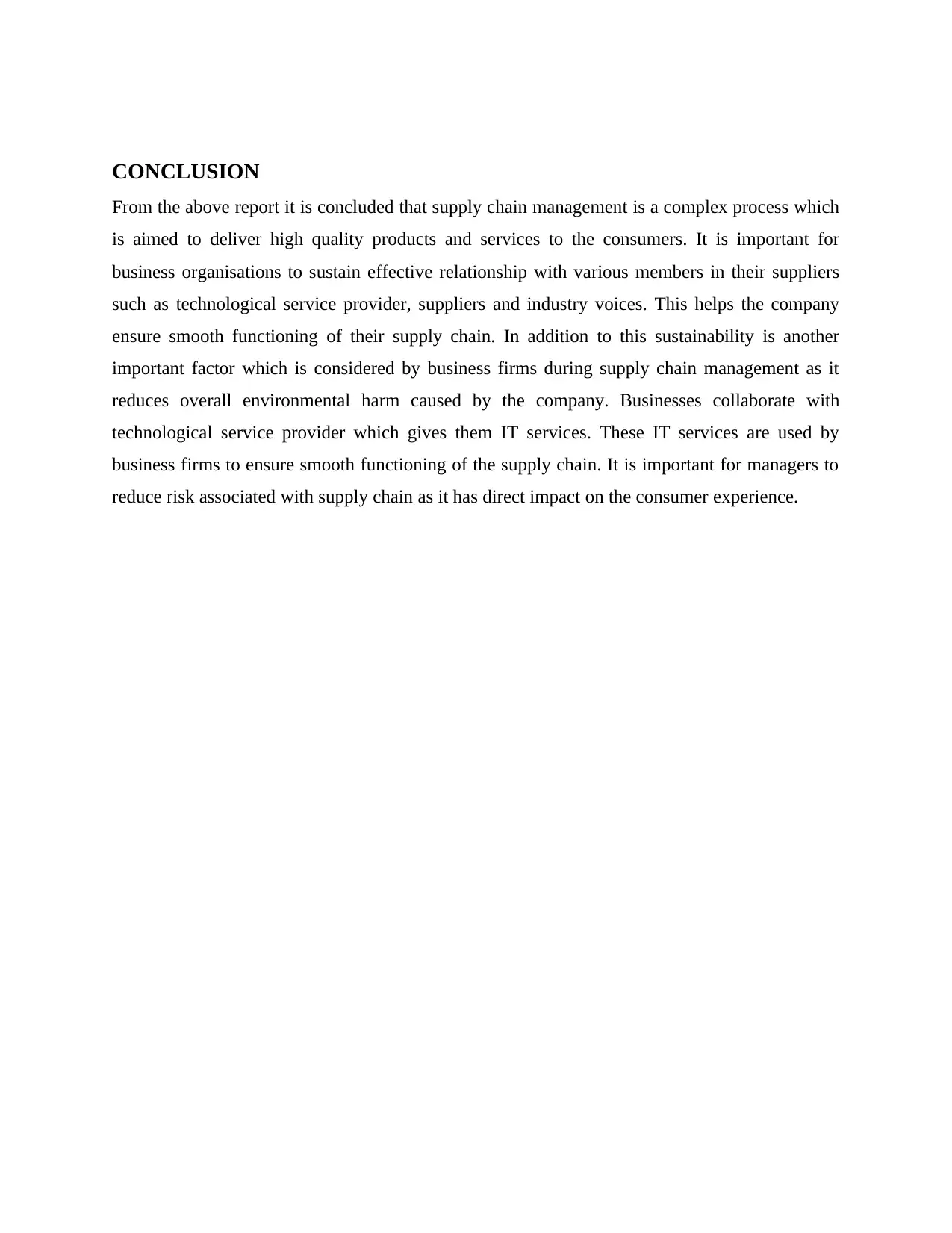
CONCLUSION
From the above report it is concluded that supply chain management is a complex process which
is aimed to deliver high quality products and services to the consumers. It is important for
business organisations to sustain effective relationship with various members in their suppliers
such as technological service provider, suppliers and industry voices. This helps the company
ensure smooth functioning of their supply chain. In addition to this sustainability is another
important factor which is considered by business firms during supply chain management as it
reduces overall environmental harm caused by the company. Businesses collaborate with
technological service provider which gives them IT services. These IT services are used by
business firms to ensure smooth functioning of the supply chain. It is important for managers to
reduce risk associated with supply chain as it has direct impact on the consumer experience.
From the above report it is concluded that supply chain management is a complex process which
is aimed to deliver high quality products and services to the consumers. It is important for
business organisations to sustain effective relationship with various members in their suppliers
such as technological service provider, suppliers and industry voices. This helps the company
ensure smooth functioning of their supply chain. In addition to this sustainability is another
important factor which is considered by business firms during supply chain management as it
reduces overall environmental harm caused by the company. Businesses collaborate with
technological service provider which gives them IT services. These IT services are used by
business firms to ensure smooth functioning of the supply chain. It is important for managers to
reduce risk associated with supply chain as it has direct impact on the consumer experience.
Secure Best Marks with AI Grader
Need help grading? Try our AI Grader for instant feedback on your assignments.
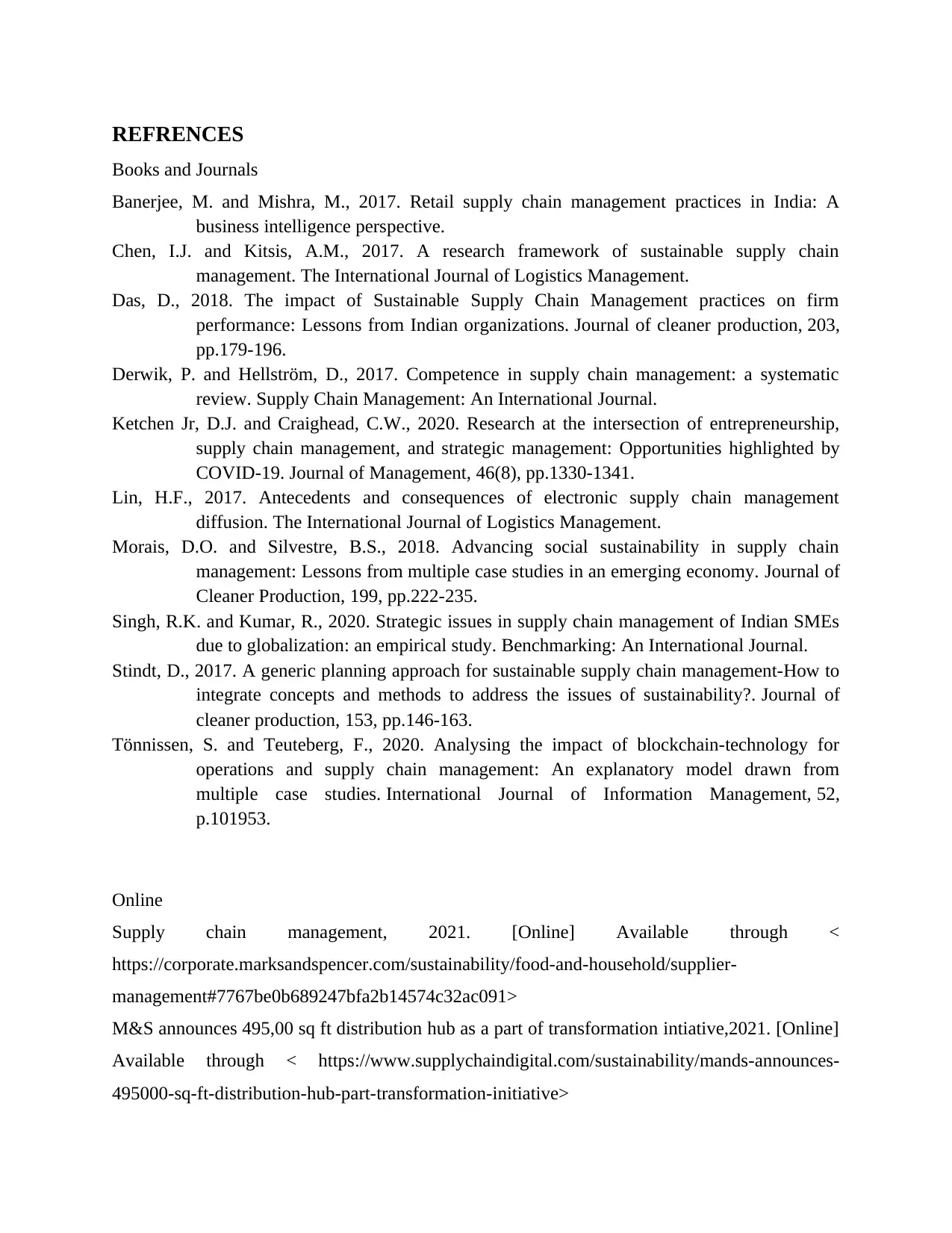
REFRENCES
Books and Journals
Banerjee, M. and Mishra, M., 2017. Retail supply chain management practices in India: A
business intelligence perspective.
Chen, I.J. and Kitsis, A.M., 2017. A research framework of sustainable supply chain
management. The International Journal of Logistics Management.
Das, D., 2018. The impact of Sustainable Supply Chain Management practices on firm
performance: Lessons from Indian organizations. Journal of cleaner production, 203,
pp.179-196.
Derwik, P. and Hellström, D., 2017. Competence in supply chain management: a systematic
review. Supply Chain Management: An International Journal.
Ketchen Jr, D.J. and Craighead, C.W., 2020. Research at the intersection of entrepreneurship,
supply chain management, and strategic management: Opportunities highlighted by
COVID-19. Journal of Management, 46(8), pp.1330-1341.
Lin, H.F., 2017. Antecedents and consequences of electronic supply chain management
diffusion. The International Journal of Logistics Management.
Morais, D.O. and Silvestre, B.S., 2018. Advancing social sustainability in supply chain
management: Lessons from multiple case studies in an emerging economy. Journal of
Cleaner Production, 199, pp.222-235.
Singh, R.K. and Kumar, R., 2020. Strategic issues in supply chain management of Indian SMEs
due to globalization: an empirical study. Benchmarking: An International Journal.
Stindt, D., 2017. A generic planning approach for sustainable supply chain management-How to
integrate concepts and methods to address the issues of sustainability?. Journal of
cleaner production, 153, pp.146-163.
Tönnissen, S. and Teuteberg, F., 2020. Analysing the impact of blockchain-technology for
operations and supply chain management: An explanatory model drawn from
multiple case studies. International Journal of Information Management, 52,
p.101953.
Online
Supply chain management, 2021. [Online] Available through <
https://corporate.marksandspencer.com/sustainability/food-and-household/supplier-
management#7767be0b689247bfa2b14574c32ac091>
M&S announces 495,00 sq ft distribution hub as a part of transformation intiative,2021. [Online]
Available through < https://www.supplychaindigital.com/sustainability/mands-announces-
495000-sq-ft-distribution-hub-part-transformation-initiative>
Books and Journals
Banerjee, M. and Mishra, M., 2017. Retail supply chain management practices in India: A
business intelligence perspective.
Chen, I.J. and Kitsis, A.M., 2017. A research framework of sustainable supply chain
management. The International Journal of Logistics Management.
Das, D., 2018. The impact of Sustainable Supply Chain Management practices on firm
performance: Lessons from Indian organizations. Journal of cleaner production, 203,
pp.179-196.
Derwik, P. and Hellström, D., 2017. Competence in supply chain management: a systematic
review. Supply Chain Management: An International Journal.
Ketchen Jr, D.J. and Craighead, C.W., 2020. Research at the intersection of entrepreneurship,
supply chain management, and strategic management: Opportunities highlighted by
COVID-19. Journal of Management, 46(8), pp.1330-1341.
Lin, H.F., 2017. Antecedents and consequences of electronic supply chain management
diffusion. The International Journal of Logistics Management.
Morais, D.O. and Silvestre, B.S., 2018. Advancing social sustainability in supply chain
management: Lessons from multiple case studies in an emerging economy. Journal of
Cleaner Production, 199, pp.222-235.
Singh, R.K. and Kumar, R., 2020. Strategic issues in supply chain management of Indian SMEs
due to globalization: an empirical study. Benchmarking: An International Journal.
Stindt, D., 2017. A generic planning approach for sustainable supply chain management-How to
integrate concepts and methods to address the issues of sustainability?. Journal of
cleaner production, 153, pp.146-163.
Tönnissen, S. and Teuteberg, F., 2020. Analysing the impact of blockchain-technology for
operations and supply chain management: An explanatory model drawn from
multiple case studies. International Journal of Information Management, 52,
p.101953.
Online
Supply chain management, 2021. [Online] Available through <
https://corporate.marksandspencer.com/sustainability/food-and-household/supplier-
management#7767be0b689247bfa2b14574c32ac091>
M&S announces 495,00 sq ft distribution hub as a part of transformation intiative,2021. [Online]
Available through < https://www.supplychaindigital.com/sustainability/mands-announces-
495000-sq-ft-distribution-hub-part-transformation-initiative>

Responsible Sourcing, 2021. [Online] Available through <
https://corporate.marksandspencer.com/sustainability/business-wide/responsible-sourcing>
https://corporate.marksandspencer.com/sustainability/business-wide/responsible-sourcing>
1 out of 12
Related Documents
Your All-in-One AI-Powered Toolkit for Academic Success.
+13062052269
info@desklib.com
Available 24*7 on WhatsApp / Email
![[object Object]](/_next/static/media/star-bottom.7253800d.svg)
Unlock your academic potential
© 2024 | Zucol Services PVT LTD | All rights reserved.



